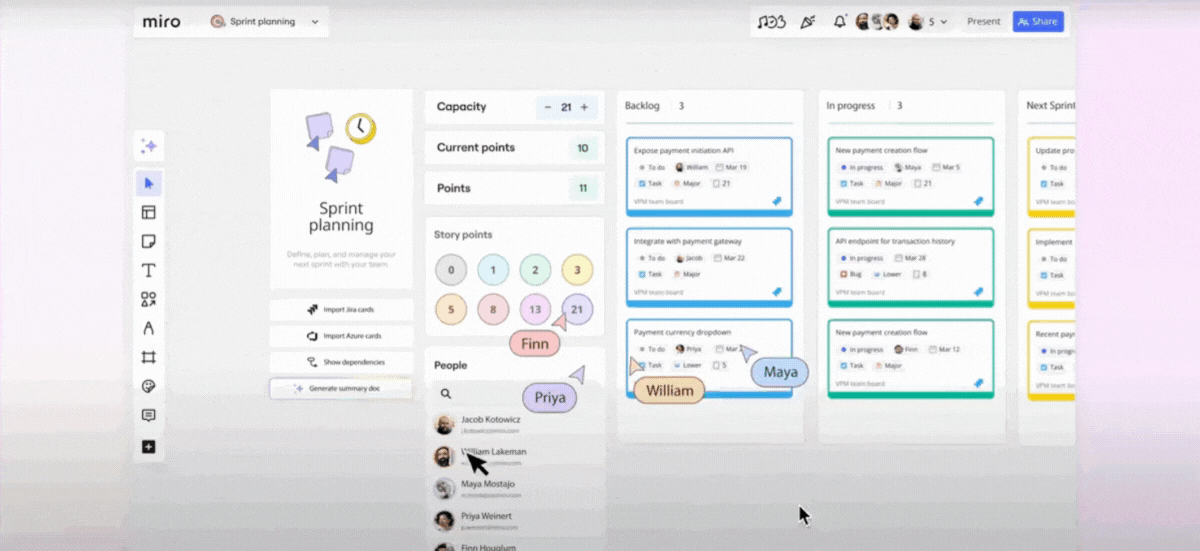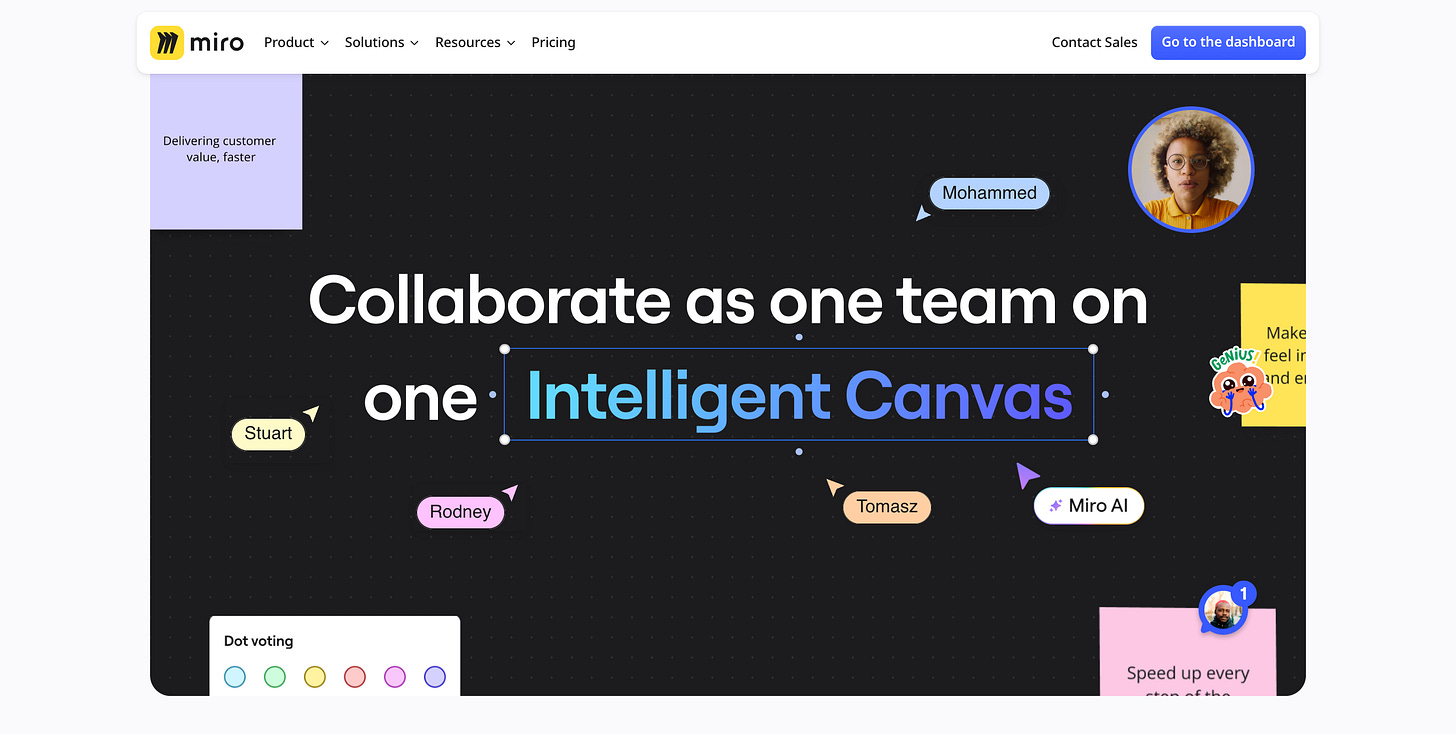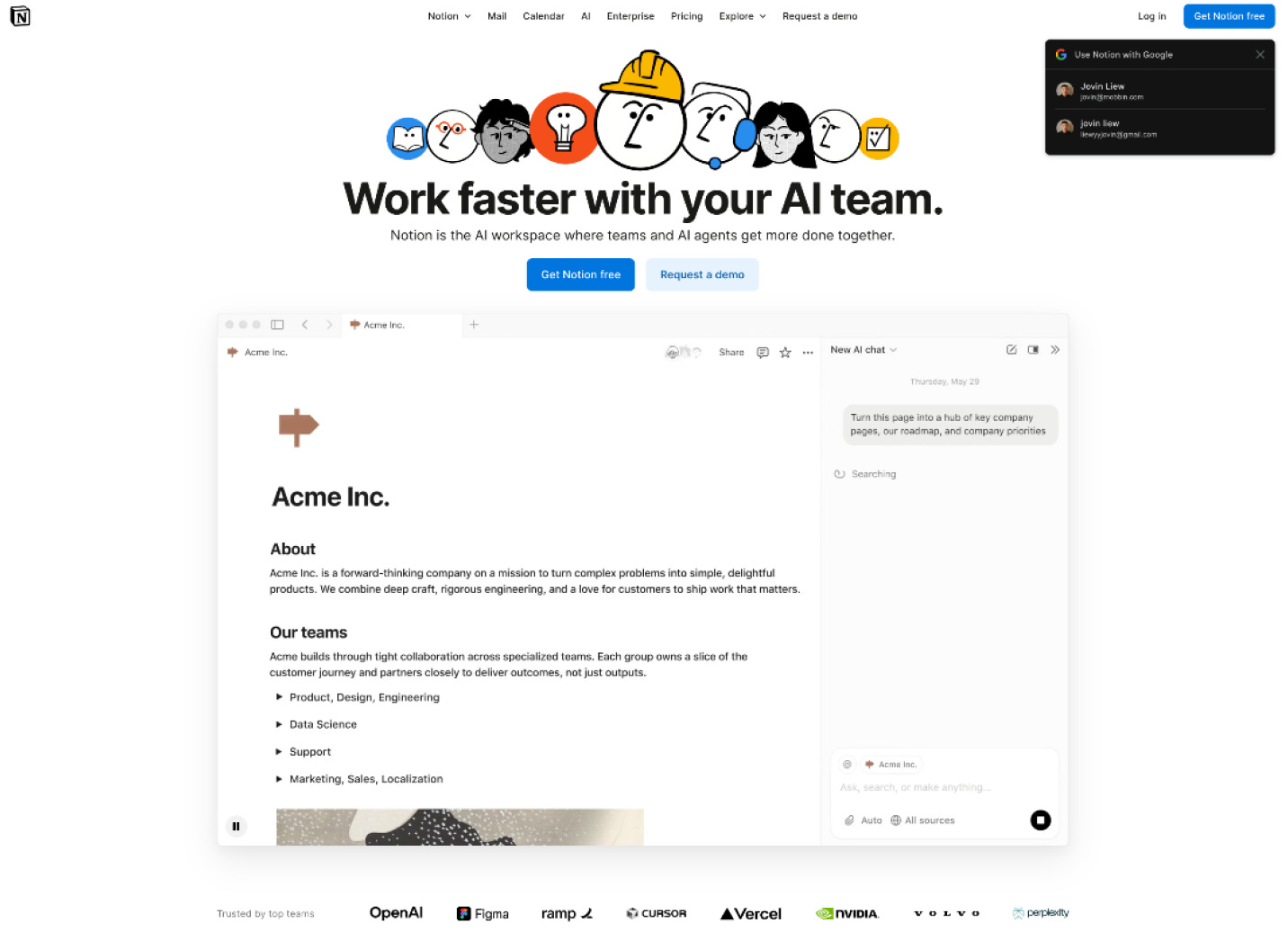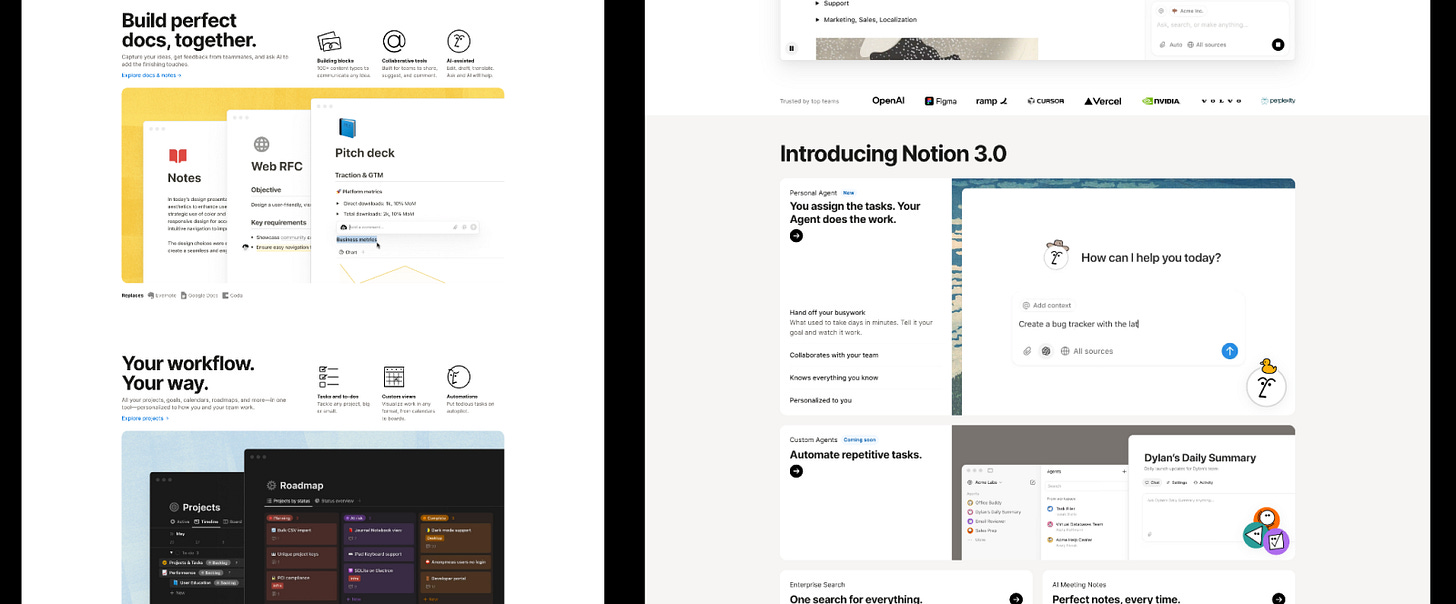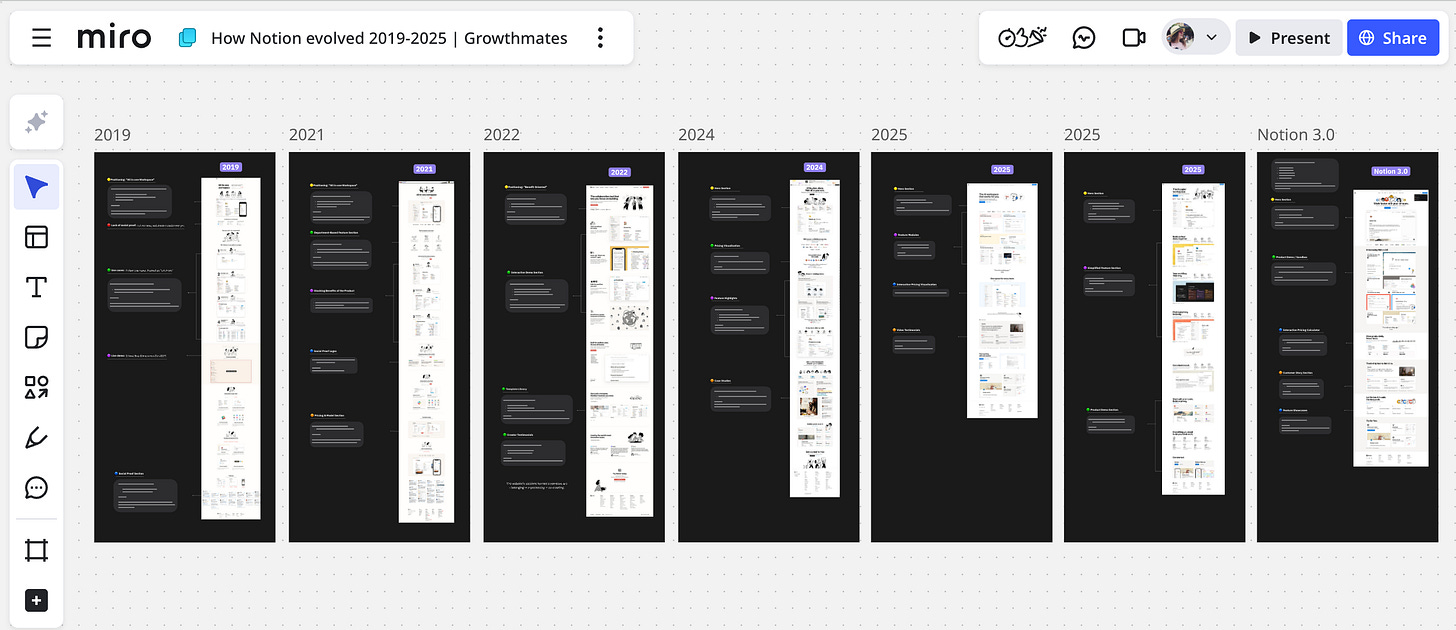How Notion and Miro Shifted to AI — The last 6 years SaaS Websites evolution 🚀
How two world-class teams evolved their websites to tell a clearer, more human product story.
Hello everyone 👋 I’m Kate Syuma, and welcome to Growthmates.news — the newsletter where we explore growth stories to inspire your professional and personal growth. Join the community of 7,000+ Product, Design, and Growth people from companies like Amplitude, Intercom, Miro, Atlassian, Grammarly, Framer, and more.
Today, I want to go back to the foundation we often take for granted — the website.
Whether it’s your full product, a new feature, or just a landing page… everything starts there. Your onboarding, your narrative, your clarity — it all begins with how your website talks to people.
So in this issue, let’s look at two fascinating examples of website evolution:
Miro’s Intelligent Canvas launch page;
Notion’s 6-year transformation from “All-in-one workspace” to “AI team workspace”.
🙏 One friendly ask: I’m preparing something special for our next chapter together. I’d love your help shaping what comes next — from the content I share to a new kind of community idea I’m exploring.
To say thank you for taking 3 minutes, you’ll receive $200 early-bird discount for my User-Centric Product-Led Growth course 🎁
Your input means a lot — it helps me make Growthmates more aligned with what you need. 💜
Before we dive in… Meet Growthmates Partners 🚀
I curate the Growthmates Bundle to share not just ideas — but the tools I trust and use in my own work. Each one is a handpicked #1 tool for a key product area, and I’m proud to have them supporting this newsletter 🖤
Best way to support Growthmates? Explore these fantastic tools below 👇
Framer — the fastest way to design and publish stunning websites (Growthmates.club is built on it).
Mobbin — the largest UX & UI reference library for deep product inspiration.
Beacon AI — the smartest AI agent for product and design teams to identify and fix UX issues that block activation, retention, and conversion.
Today’s edition is about websites that evolved — not just visually, but strategically. Two product-led stars (Miro and Notion) have turned their websites into immersive, product-like experiences that sell without saying “Buy now”.
But why are websites evolving this way? Because traditional conversion tactics aren’t enough anymore. Most B2B websites convert only 2–5% of their visitors — and that’s average.
Top-performing B2B companies reach around 11.7%, meaning that for every 100 visitors, only about 12 prospects actually convert into leads or trial users. That’s a huge gap.
🎯 The truth is: conversion is not just about copy or CTAs anymore — it’s about experience. Your website is your product story. And Miro and Notion are perfect case studies of how design, interaction, and storytelling can make users feel the value before they even sign up.
1. Miro’s “Intelligent Canvas” Launch Page
When Miro introduced Intelligent Canvas, it wasn’t just a new feature — it was a story about how the product thinks with you.
The name feels natural, clear, and human. Instead of pushing a trial, Miro invites users to watch the keynote — leading with learning, not pressure.
Visuals play a key role here: showing real use cases (like sprint planning and retrospectives) turns abstract “AI” into something tangible.
The only weak point? Some heavy copy later on (“single pane of glass”) slightly dilutes clarity.
So, here are a few highlights:
Naming That Sticks: “Intelligent Canvas” instantly communicates what it is. Miro found the balance — the name feels smart, simple, and now lives across their whole product narrative.
The Unusual CTA: Instead of the usual “Try now,” they went with “Watch the keynote.” It’s an educational first step — showing that sometimes awareness and understanding come before sign-ups.
👉 The key takeaway: Miro positions intelligence as collaboration, not automation. Further in this issue, we will dive deeper into this case.
Notion 3.0 — “Your AI Workspace”
If you’ve followed Notion’s evolution, you know this company never rushes a launch — they refine positioning first, then design around it.
Back in 2019, they didn’t even go live until they could deliver on their promise of being an “all-in-one workspace.” This is one of the core High-quality principles that Notion has maintained for years.
Since then, Notion has evolved from a personal productivity tool into a team-first, AI-powered platform.
Now we can see a very big shift towards bigger company scale... AI + Human collaboration became a big theme.
What’s most interesting is how this evolution shows up on their site:
From Features to Outcomes:
Earlier, Notion showcased “notes, docs, databases.” Now the site talks in user promises — “You assign the tasks. Your Agent does the work.”
It’s subtle, but it shifts focus from what you do in Notion to why it matters for teams.
🎯 Wondering how I uncover all these references?
If you love studying product evolution, check out Mobbin Version History — you can explore how products like Airbnb, Duolingo, Notion, and more evolve in real time. The library is still evolving, but you can already find 1000+ apps there 😉
For example, you can search through screens and flows from Notion that have been collected since 2022, and even request an update. Check it yourself on Mobbin →
Community & Templates:
Templates — which were missing on earlier versions — are now core to the story.
Notion connects users to a “global ecosystem of creators,” highlighting that the product isn’t just software but a movement shaped by its community.
👉 The key takeaway: The Notion 3.0 launch isn’t about adding AI — it’s about reframing the product for scale. It’s no longer just a workspace — it’s an intelligent ecosystem where teams and AI co-create.
🎁 Bonus Miro Board:
I created this Miro Board with a deep dive and a full Notion teardown (2019-2025) year by year) — how design, focus, and narrative shifted in 6 years:
💌 That’s the free edition — for a deeper look and the full breakdown of Miro changes and Notion’s evolution over time, check out the paid section below.
👉 In the paid edition, you’ll find:
Full 30-minute video teardown over Miro Landing and Notion 6-year evolution with my voice-over walkthrough;
Figma File with 5 more extended teardown examples of SaaS LPs.
Deep Breakdowns of Miro’s “Intelligent Canvas” and Notion 3.0.
Keep reading with a 7-day free trial
Subscribe to Growthmates with Kate Syuma to keep reading this post and get 7 days of free access to the full post archives.








